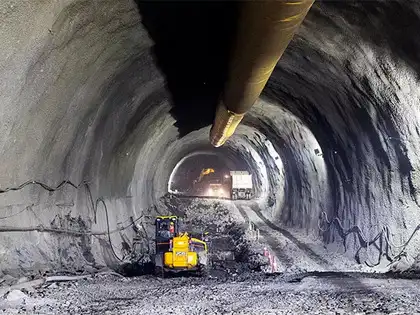
Bullet Train
In a groundbreaking achievement for India’s ambitious Mumbai-Ahmedabad Bullet Train Project, the first section of the 21-kilometer-long undersea tunnel — the country’s first of its kind — has been successfully completed. This historic engineering feat marks a significant step forward in bringing high-speed rail to India, a project that aims to revolutionize travel between Mumbai and Ahmedabad.
The tunnel is a key part of the larger Mumbai-Ahmedabad High-Speed Rail (MAHSR) corridor, and once operational, it will allow Japan-made E10 series bullet trains to race beneath the Arabian Sea at speeds of up to 320 km/h.
A Glimpse Into the Engineering Marvel
The undersea tunnel, stretching across Thane Creek near Mumbai, is a major component of the 508-km corridor. Of the 21 kilometers, about 7 km runs directly under the sea, while the rest passes through highly challenging geological zones beneath mangroves, rivers, and densely populated areas.
National High-Speed Rail Corporation Limited (NHSRCL), which is overseeing the construction, confirmed the completion of the first tunnel section earlier this week. The achievement was made possible using the New Austrian Tunneling Method (NATM), along with advanced Tunnel Boring Machines (TBMs) sourced from international manufacturers.
NHSRCL stated, “This marks a moment of pride for Indian infrastructure. Our teams, along with Japanese experts, have worked round the clock to complete this milestone safely and ahead of schedule.”
Why This Tunnel Matters
This 21-kilometer undersea tunnel is not just a construction challenge — it’s a symbolic and strategic leap. It will allow the bullet train to bypass the highly congested Mumbai urban region and reach the upcoming Bandra Kurla Complex (BKC) terminal swiftly and safely.
Once operational, the bullet train will emerge directly at the heart of Mumbai, enabling commuters to travel between Mumbai and Ahmedabad in under three hours — a journey that currently takes 6 to 7 hours by conventional train.
This project, once seen as a dream, is now becoming a reality with each completed section — and the undersea tunnel is among the most complex of all.
Meet the E10 Bullet Trains
The corridor will be served by Japan’s cutting-edge E10 Series Shinkansen trains, designed specifically for Indian conditions. These high-speed electric trains will be capable of reaching speeds of 320 km/h and are equipped with the latest safety features, including seismic detection, automatic braking systems, and superior aerodynamics to minimize air resistance and noise.
Each train will have 10 coaches, equipped with modern amenities like Wi-Fi, infotainment systems, spacious seating, and dedicated compartments for differently-abled passengers.
The E10 series is being built under the “Make in India” initiative, with technology transfer from Japan, and will gradually be assembled and manufactured in India.
Progress on the Bullet Train Corridor
As of July 2025, construction is progressing rapidly across all three sections — Maharashtra, Gujarat, and the Union Territory of Dadra & Nagar Haveli. Over 300 kilometers of viaducts (elevated tracks) are under various stages of completion, along with key stations like Surat, Vapi, and Vadodara nearing structural readiness.
The BKC terminal in Mumbai is being designed as a world-class underground station, with high-speed escalators, smart ticketing systems, and direct metro connectivity.
NHSRCL officials have reaffirmed that the first phase of the bullet train corridor — between Surat and Bilimora — is expected to be operational by mid-2027. The full stretch between Mumbai and Ahmedabad is slated for completion by 2030, barring unforeseen delays.
Environmental and Safety Measures
Given the sensitivity of the tunnel’s location — passing under marine and mangrove ecosystems — NHSRCL has incorporated multiple safety and eco-friendly measures. Special attention has been paid to reduce vibrations, minimize water ingress, and avoid damage to marine life.
The tunnel walls are lined with special waterproof concrete, and multi-layered monitoring systems are in place to ensure real-time tracking of pressure, leaks, and structural integrity.
Additionally, environmental clearances were obtained with strict compliance, including consultation with marine biologists and environmentalists to minimize impact.
Public Excitement and Global Attention
The successful completion of the undersea tunnel’s first section has captured public imagination and international attention. Infrastructure enthusiasts, urban planners, and transportation experts worldwide are lauding India’s foray into next-gen rail connectivity.
Social media is buzzing with videos and images of the tunnel excavation process, with hashtags like #BulletTrainIndia and #UnderseaTunnelSuccess trending across platforms.
Conclusion
The completion of the first leg of India’s longest undersea tunnel is a monumental achievement — not just for the bullet train project, but for the future of Indian infrastructure. As the nation marches toward high-speed rail connectivity, projects like these underline India’s capacity to dream big and deliver on complex, globally competitive engineering marvels.
The dream of boarding a bullet train in Mumbai and reaching Ahmedabad in under three hours is now inching closer to reality — and with every tunnel dug and viaduct raised, India’s future speeds forward.
Thanks For Reading